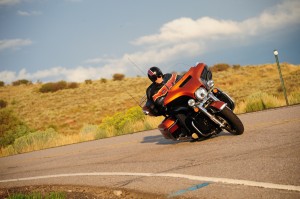You’ve committed to a corner, your big V-twin cruiser is leaned over and all of a sudden you hit a bit of a dip in the road surface.
The next few moments leave you with sweaty palms and a racing heart at the least … in hospital at the worst!
The foot pegs dig into the tarmac, then the exhaust scrapes across the surface, then the side stand hits the ground.
That lifts the rear wheel off the ground and the back tyre skips sideways which stands the bike up and sends you wide in the corner …
I love riding a cruiser, but cornering can be a bit of a chore and sudden surprises like the one I just describe can be unnerving and lead to disaster.
However, just because you ride a cruiser doesn’t mean you have to roll around the corners like Miss Daisy.
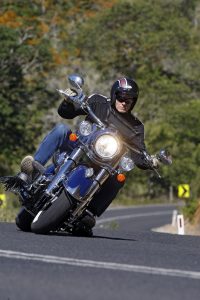
After many years of trying to perfect the technique, I think I’ve discovered a few clues to safer and faster cruiser cornering.
Obviously the low clearance is the major problem.
What makes this worse is the long wheelbase, forward foot controls, plush suspension, long and low pipes, raked-out forks and even low panniers.
It seems everything is against rapid cornering. But you’ve got to work with what you’ve got and make the best of it.
You can make things a little easier on yourself by adjusting the rear shock and spring for greater stiffness and damping, and keeping luggage weight off the rear end. There is not much you can do about the clearance issues.
For a while I tried using my foot to pull up the inside peg just before going around a corner, but it’s pointless. Scraping pegs is not the problem as they usually pivot upwards, anyway.
It’s the hard furniture – sidestands, exhausts and various brackets – underneath the bike that cause the main issues.
The problem isn’t so much static lean angle as dynamic lean angle. Static lean angle is the angle at which the bike can tilt when standing still before something touches the ground. Dynamic lean angle is the angle where things start to touch when moving.
Plush suspension, bumps in the road surface, luggage weight and riding style can substantially affect the dynamic lean angle, usually making it worse.
This became evident to me on the launch of Harley-Davidson’s new Touring machines in Colorado this year. They talked about how the dynamic lean angle had been improved by a stiffer chassis and front forks, despite the static lean angle remaining the same.
I pondered this for a while, spoke to several cruiser riders about their riding style and then put my theories to the test on the Street Glide I am currently testing. Read my review here.
 FIVE TIPS
FIVE TIPS
- The first idea is to have the bike as high on its suspension as possible when cornering for the best clearance. Any braking makes the bike sit down on its suspension. Front braking compresses the forks, but raises the rear and vice versa. So the first point to make is that you need to get all your braking over with before entering the corner. No trail braking, either.
- On the reverse side, acceleration makes the bike lift a little on its front suspension and very minimally squat on the rear. So the second point is that you need to be slightly accelerating through the corner. That means selecting and engaging the right gear before you initiate the turn-in.
- The sound of foot pegs scraping across the road are usually an indication that you are nearing the maximum lean angle, so use that as a gauge. You do not want to be scraping the foot pegs on the entry to the apex. If the corner tightens and you need to tighten your arc the only way to do that is with more lean angle and you have almost run out of that. Hitting the brakes will also make matters worse as it will compress suspension and reduce clearance. Having selected a low gear means that you can tighten your line but simply rolling off a little throttle. One of the joys of low clearance cruisers is constant radius corners. They can be a heap of fun as you can hold the foot peg on the ground all the way around the bend, knowing you are very close to the lean limit.
- The next point is that you need to make the corner arc as big as possible without running wide on the exit. The bigger the corner arc, the less lean angle you need. That means a late turn-in with an early apex. That way, you will also see further around the corner and have a sooner indication of whether you need to tighten your arc or open up your line. But beware of the sudden flick into the corner as this will load the front forks. Turn smoothly into the corner so the suspension is not compressed.
- Finally, to make a bike turn more than its lean angle, you need to shift your weight to the inside of the bike. Now, getting your knee down on a cruiser is pretty much out of the question because of the riding position and height of the bars. However, you can help a little by moving your body position forward and inside by sitting up straight, then leaning the top of your body toward the inside mirror as you turn into the corner. Leaning your body doesn’t have a huge impact on steering or cornering, but it will give you those few precious millimetres of clearance to complete the turn without drama.
These same techniques apply for just about any bike, but with a few subtle differences. Practise them at slow speeds first and see if they suit your style and improve your clearance issues.
If you’ve got any further suggestions on cornering on a cruiser, please leave your comments in the box below.


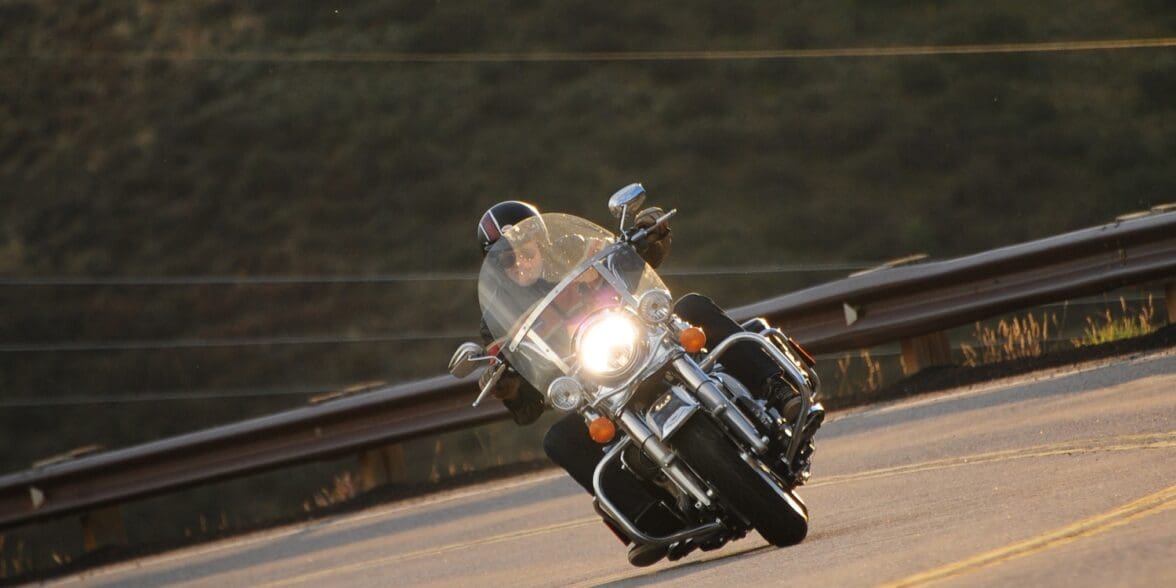
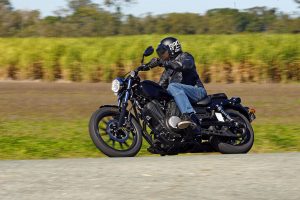
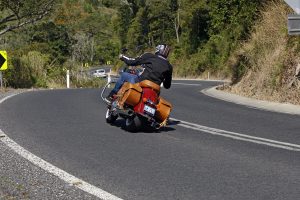 FIVE TIPS
FIVE TIPS